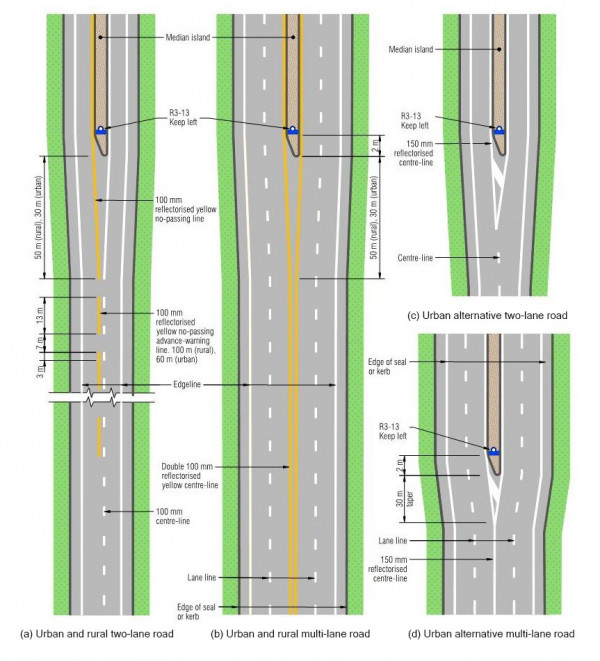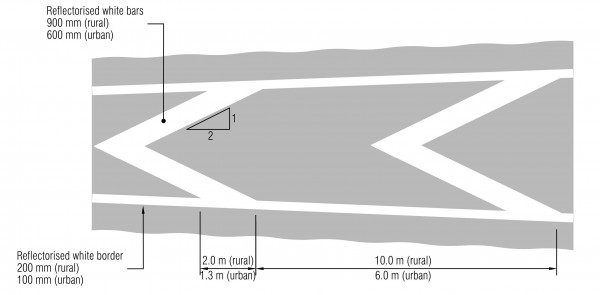The TCD rule clause 7.7(2) states markings or delineators must be provided on the roadway beside raised traffic islands to inform drivers of the presence and extent of the traffic island.
Markings should be provided in advance of traffic islands and other features on the road surface to warn of potential hazards.
Features that separate opposing traffic (refer to medians and median islands) should be marked differently from features that separate diverging traffic section (refer to traffic islands separating diverging traffic).
Traffic islands separating diverging traffic
At median islands, the following marking should be installed:
Where the feature is located on a road which is illuminated, and vehicle speeds are low, markings on approach to the island may be omitted if the RCA considers that it is safe to do so.
Table 6‑3: Centre-line markings specifications for approaches to median islands
|
|
Urban or rural |
Urban alternative |
|---|---|---|
|
Colour |
Reflectorised yellow |
Reflectorised white |
|
Width |
100mm |
150mm |
|
Location |
To the left of an acceptable line type, described in: |
As illustrated in Figure 6‑1(c)
|
|
Stripe |
Continuous |
Continuous |
|
Length |
50m minimum rural |
30m minimum |
|
Advance warning |
As for no passing line |
None required |
Figure 6-1: Markings in advance of medians or median islands

View larger image [JPG, 172 KB]
Where traffic islands separate diverging traffic (or traffic travelling in the same direction) such as in advance of a raised left turn island or major diverge of traffic they should be marked with chevron markings.
The approach marking should consist of two diverging reflectorised white lines enclosing a broad chevron pattern of reflectorised white bars (chevrons) as shown in Figure 6‑2(a).
Markings on approaches to raised traffic islands separating diverging traffic should be marked as follows in Table 6‑4 and Figure 6‑2.
Table 6‑4: Markings in advance of traffic islands separating diverging traffic
|
|
Diverging |
|
|---|---|---|
|
Urban |
Rural |
|
|
Colour |
Reflectorised white |
Reflectorised white |
|
Border width |
100mm |
200mm |
|
Bar width |
600mm |
900mm |
|
Bar spacing |
6.0m |
10.0m |
|
Bar slope |
2:1 |
2:1 |
|
Stripe |
N/A |
N/A |
|
Length |
30m minimum |
50m minimum |
Figure 6-2: Markings in advance of traffic islands separating diverging traffic
View larger image [JPG, 1.4 MB]
(b) Chevron marking details

View larger image [JPG, 285 KB]
Figure 6-2 note:
The default length of the diverge taper should be 50m for rural situations and 30m for urban situations as illustrated in Figure 6‑2 (b). However, the calculation included in audio tactile profiled roadmarkings should be used for cases to determine whether a greater length of diverge taper is required. Similarly, for merging on departure from a feature, the calculation included in audio tactile profiled roadmarkings should be used to determine the length of merge taper required.